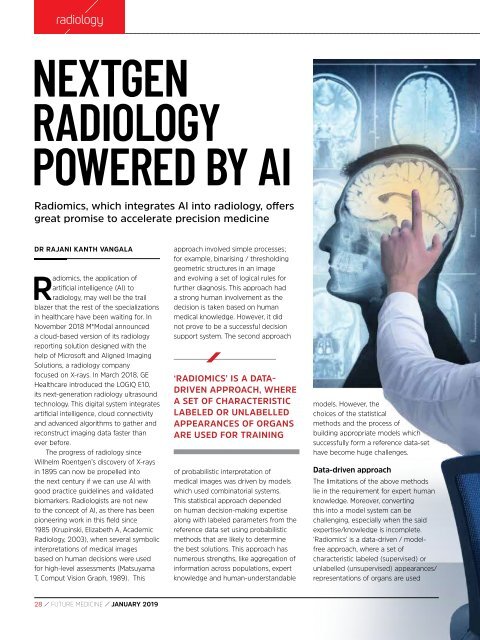FM JANUARY 2019 - digital edition
Create successful ePaper yourself
Turn your PDF publications into a flip-book with our unique Google optimized e-Paper software.
adiology<br />
NEXTGEN<br />
RADIOLOGY<br />
POWERED BY AI<br />
Radiomics, which integrates AI into radiology, offers<br />
great promise to accelerate precision medicine<br />
DR RAJANI KANTH VANGALA<br />
Radiomics, the application of<br />
artificial intelligence (AI) to<br />
radiology, may well be the trail<br />
blazer that the rest of the specializations<br />
in healthcare have been waiting for. In<br />
November 2018 M*Modal announced<br />
a cloud-based version of its radiology<br />
reporting solution designed with the<br />
help of Microsoft and Aligned Imaging<br />
Solutions, a radiology company<br />
focused on X-rays. In March 2018, GE<br />
Healthcare introduced the LOGIQ E10,<br />
its next-generation radiology ultrasound<br />
technology. This <strong>digital</strong> system integrates<br />
artificial intelligence, cloud connectivity<br />
and advanced algorithms to gather and<br />
reconstruct imaging data faster than<br />
ever before.<br />
The progress of radiology since<br />
Wilhelm Roentgen’s discovery of X-rays<br />
in 1895 can now be propelled into<br />
the next century if we can use AI with<br />
good practice guidelines and validated<br />
biomarkers. Radiologists are not new<br />
to the concept of AI, as there has been<br />
pioneering work in this field since<br />
1985 (Krupinski, Elizabeth A, Academic<br />
Radiology, 2003), when several symbolic<br />
interpretations of medical images<br />
based on human decisions were used<br />
for high-level assessments (Matsuyama<br />
T, Comput Vision Graph, 1989). This<br />
approach involved simple processes;<br />
for example, binarising / thresholding<br />
geometric structures in an image<br />
and evolving a set of logical rules for<br />
further diagnosis. This approach had<br />
a strong human involvement as the<br />
decision is taken based on human<br />
medical knowledge. However, it did<br />
not prove to be a successful decision<br />
support system. The second approach<br />
‘RADIOMICS’ IS A DATA-<br />
DRIVEN APPROACH, WHERE<br />
A SET OF CHARACTERISTIC<br />
LABELED OR UNLABELLED<br />
APPEARANCES OF ORGANS<br />
ARE USED FOR TRAINING<br />
of probabilistic interpretation of<br />
medical images was driven by models<br />
which used combinatorial systems.<br />
This statistical approach depended<br />
on human decision-making expertise<br />
along with labeled parameters from the<br />
reference data set using probabilistic<br />
methods that are likely to determine<br />
the best solutions. This approach has<br />
numerous strengths, like aggregation of<br />
information across populations, expert<br />
knowledge and human-understandable<br />
models. However, the<br />
choices of the statistical<br />
methods and the process of<br />
building appropriate models which<br />
successfully form a reference data-set<br />
have become huge challenges.<br />
Data-driven approach<br />
The limitations of the above methods<br />
lie in the requirement for expert human<br />
knowledge. Moreover, converting<br />
this into a model system can be<br />
challenging, especially when the said<br />
expertise/knowledge is incomplete.<br />
‘Radiomics’ is a data-driven / modelfree<br />
approach, where a set of<br />
characteristic labeled (supervised) or<br />
unlabelled (unsupervised) appearances/<br />
representations of organs are used<br />
28 / FUTURE MEDICINE / <strong>JANUARY</strong> <strong>2019</strong>


















